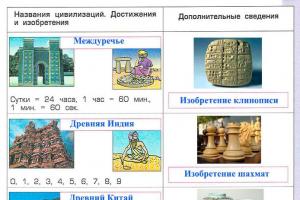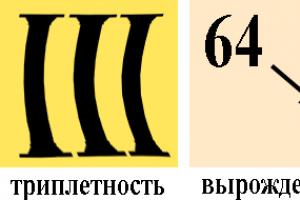Alkali metals (ALM) are all elements of group IA of the periodic table, i.e. lithium Li, sodium Na, potassium K, rubidium Rb, cesium Cs, francium Fr.
AM atoms have only one electron per outer electron level. s- sublevel, easily detached during chemical reactions. In this case, a positively charged particle is formed from a neutral atom of alkali metal - a cation with a charge of +1:
M 0 – 1 e → M +1
The alkali metal family is the most active among other groups of metals, and therefore in nature they are found in free form, i.e. in the form of simple substances is impossible.
Simple substances, alkali metals, are extremely strong reducing agents.
Interaction of alkali metals with nonmetals
with oxygen
Alkali metals react with oxygen already at room temperature, and therefore they need to be stored under a layer of some hydrocarbon solvent, such as, for example, kerosene.
The interaction of alkali metal with oxygen leads to different products. Only lithium reacts with oxygen to form an oxide:
4Li + O 2 = 2Li 2 O
In a similar situation, sodium forms with oxygen sodium peroxide Na 2 O 2:
2Na + O 2 = Na 2 O 2,
and potassium, rubidium and cesium are predominantly superoxides (superoxides), with the general formula MeO 2:
Rb + O 2 = RbO 2
with halogens
Alkali metals react actively with halogens, forming alkali metal halides having an ionic structure:
2Li + Br 2 = 2LiBr lithium bromide
2Na + I 2 = 2NaI sodium iodide
2K + Cl 2 = 2KCl potassium chloride
with nitrogen
Lithium reacts with nitrogen already at ordinary temperatures, while nitrogen reacts with other alkali metals when heated. In all cases, alkali metal nitrides are formed:
6Li + N 2 = 2Li 3 N lithium nitride
6K + N 2 = 2K 3 N potassium nitride
with phosphorus
Alkali metals react with phosphorus when heated, forming phosphides:
3Na + P = Na 3 P sodium phosphide
3K + P = K 3 P potassium phosphide
with hydrogen
Heating of alkali metals in a hydrogen atmosphere leads to the formation of alkali metal hydrides containing hydrogen in a rare oxidation state - minus 1:
N 2 + 2K = 2KH -1 potassium hydride
H 2 + 2Rb = 2RbH rubidium hydride
with sulfur
The interaction of alkali metal with sulfur occurs upon heating with the formation of sulfides:
S + 2K = K 2 S sulfide potassium
S + 2Na = Na 2 S sodium sulfide
Interaction of alkali metals with complex substances
with water
All alkali metals actively react with water to form hydrogen gas and alkali, which is why these metals received the corresponding name:
2HOH + 2Na = 2NaOH + H2
2K + 2HOH = 2KOH + H2
Lithium reacts with water quite calmly, sodium and potassium spontaneously ignite during the reaction, and rubidium, cesium and francium react with water with a powerful explosion.
with halogenated hydrocarbons (Wurtz reaction):
2Na + 2C 2 H 5 Cl → 2NaCl + C 4 H 10
2Na + 2C 6 H 5 Br → 2NaBr + C 6 H 5 –C 6 H 5
with alcohols and phenols
APs react with alcohols and phenols, replacing hydrogen in the hydroxyl group of an organic substance:
2CH 3 OH + 2K = 2CH 3 OK + H 2
potassium methoxide
2C 6 H 5 OH + 2Na = 2C 6 H 5 ONa + H 2
sodium phenolate
The chemical properties of alkali and alkaline earth metals are similar. The outer energy level of alkali metals has one electron, and that of alkaline earth metals has two. During reactions, metals easily part with valence electrons, exhibiting the properties of a strong reducing agent.
Alkaline
Group I of the periodic table includes alkali metals:
- lithium;
- sodium;
- potassium;
- rubidium;
- cesium;
- French

Rice. 1. Alkali metals.
They are distinguished by their softness (can be cut with a knife), low melting and boiling points. These are the most active metals.
The chemical properties of alkali metals are presented in the table.
|
Reaction |
Peculiarities |
The equation |
|
With oxygen |
They oxidize quickly in air. Lithium forms oxide at temperatures above 200°C. Sodium forms a mixture of 80% peroxide (R 2 O 2) and 20% oxide. The remaining metals form superoxides (RO 2) |
4Li + O 2 → 2Li 2 O; 2Na + O 2 → Na 2 O 2 ; Rb + O 2 → RbO 2 |
|
Only lithium reacts at room temperature |
6Li + N 2 → 2Li 3 N |
|
|
With halogens |
The reaction is vigorous |
2Na + Cl 2 → 2NaCl |
|
With non-metals |
When heated. They form sulfides, hydrides, phosphides, and silicides. Only lithium and sodium react with carbon, forming carbides |
2K + S → K 2 S; 2Na + H 2 → 2NaH; 2Cs + 5P → Cs 2 P 5 ; Rb + Si → RbSi; 2Li + 2C → Li 2 C 2 |
|
Only lithium reacts calmly. Sodium burns with a yellow flame. Potassium reacts with a flash. Cesium and rubidium explode |
2Na + 2H 2 O → 2NaOH + H 2 - |
|
|
With acids |
They react explosively with hydrochloric, phosphoric, and dilute sulfuric acids. When reacting with concentrated sulfuric acid, hydrogen sulfide is released, with concentrated nitric acid it forms nitric oxide (I), with dilute nitric acid - nitrogen |
2Na + 2HCl → 2NaCl + H 2 ; 8Na + 5H 2 SO 4 (conc) → 4Na 2 SO 4 + H 2 S + 4H 2 O; 8K + 10HNO 3 (conc) → 8KNO 3 + N 2 O + 5H 2 O; 10Na + 12HNO 3 (diluted) → N 2 + 10NaNO 3 + 6H 2 O |
|
With ammonia |
Form amines |
2Li + 2NH 3 → 2LiNH 2 + H 2 |
Can react with organic acids and alcohols.
Alkaline earth
In group II of the periodic table there are alkaline earth metals:
- beryllium;
- magnesium;
- calcium;
- strontium;
- barium;
- radium.

Rice. 2. Alkaline earth metals.
Unlike alkali metals, they are harder. Only strontium can be cut with a knife. The densest metal is radium (5.5 g/cm3).
Beryllium reacts with oxygen only when heated to 900°C. Does not react with hydrogen and water under any conditions. Magnesium oxidizes at a temperature of 650°C and reacts with hydrogen under high pressure.
The table shows the main chemical properties of alkaline earth metals.
|
Reaction |
Peculiarities |
The equation |
|
With oxygen |
Form oxide films. Self-ignites when heated to 500°C |
2Mg + O 2 → 2MgO |
|
With hydrogen |
At high temperatures they form hydrides |
Sr + H 2 → SrH 2 |
|
With halogens and non-metals |
React when heated |
Be + Cl 2 → BeCl 2 ; Mg + S → MgS; 3Ca + 2P → Ca 3 P 2 ; 3Ca + N 2 → Ca 3 N 2; Ba + 2C → BaC 2 |
|
At room temperature |
Mg + 2H 2 O → Mg(OH) 2 + H 2 |
|
|
With acids |
All metals react to form salts |
4Ca + 10HNO 3 (conc.) → 4Ca(NO 3) 2 + N 2 O + 5H 2 O |
|
With alkalis |
Only beryllium reacts |
Be + 2NaOH + 2H 2 O → Na 2 + H 2 |
|
Substitution |
Replace less active metals in oxides. The exception is beryllium. |
2Mg + ZrO 2 → Zr + 2MgO |
Alkali and alkaline earth metal ions in salts are easily detected by changes in flame color. Sodium salts burn with a yellow flame, potassium - violet, rubidium - red, calcium - brick-red, barium - yellow-green. Salts of these metals are used to create fireworks.

Rice. 3. Qualitative reaction.
What have we learned?
Alkali and alkaline earth metals are active elements of the periodic table that react with simple and complex substances. Alkali metals are softer, react violently with water and halogens, easily oxidize in air, forming oxides, peroxides, superoxides, and interact with acids and ammonia. When heated, they react with non-metals. Alkaline earth metals react with nonmetals, acids, and water. Beryllium does not react with hydrogen and water, but reacts with alkalis and oxygen at high temperatures.
Test on the topic
Evaluation of the report
Average rating: 4.3. Total ratings received: 106.
The concept of alkaline earth metals includes part of the elements of group II of the periodic system: beryllium, magnesium, calcium, strontium, barium, radium. The last four metals have the most pronounced signs of the alkaline earth classification, therefore, in some sources, beryllium and magnesium are not included in the list, limiting themselves to four elements.
The metal got its name due to the fact that when their oxides interact with water, an alkaline environment is formed. Physical properties of alkaline earth metals: all elements have a gray metallic color, under normal conditions they have a solid structure, with increasing atomic number their density increases, and have a very high melting point. Unlike alkali metals, elements of this group cannot be cut with a knife (with the exception of strontium). Chemical properties of alkaline earth metals: they have two valence electrons, activity increases with increasing atomic number, and act as a reducing agent in reactions.
The characteristics of alkaline earth metals indicate their high activity. This especially applies to elements with a large serial number. For example, beryllium under normal conditions does not interact with oxygen and halogens. To trigger the reaction mechanism, it must be heated to a temperature of over 600 degrees Celsius. Magnesium under normal conditions has an oxide film on the surface and also does not react with oxygen. Calcium oxidizes, but rather slowly. But strontium, barium and radium oxidize almost instantly, so they are stored in an oxygen-free environment under a kerosene layer.
All oxides increase their basic properties with increasing atomic number of the metal. Beryllium hydroxide is an amphoteric compound that does not react with water, but is highly soluble in acids. Magnesium hydroxide is a weak alkali, insoluble in water, but reactive with strong acids. Calcium hydroxide is a strong, slightly water-soluble base that reacts with acids. Barium and strontium hydroxides are strong bases that are highly soluble in water. And radium hydroxide is one of the strongest alkalis that reacts well with water and almost all types of acids.
Methods of obtaining
Alkaline earth metal hydroxides are prepared by exposing the pure element to water. The reaction proceeds at room conditions (except for beryllium, which requires an increase in temperature) with the evolution of hydrogen. When heated, all alkaline earth metals react with halogens. The resulting compounds are used in the production of a wide range of products from chemical fertilizers to ultra-precision microprocessor parts. Alkaline earth metal compounds exhibit the same high activity as pure elements, which is why they are used in many chemical reactions.

Most often this occurs during exchange reactions, when it is necessary to displace a less active metal from a substance. They take part in redox reactions as a strong reducing agent. Divalent cations of calcium and magnesium give water so-called hardness. Overcoming this phenomenon occurs by precipitating ions using physical action or adding special softening substances to the water. Alkaline earth metal salts are formed by dissolving elements in acid or as a result of exchange reactions. The resulting compounds have a strong covalent bond and therefore have low electrical conductivity.
In nature, alkaline earth metals cannot be found in pure form, since they quickly interact with the environment, forming chemical compounds. They are part of minerals and rocks contained in the thickness of the earth's crust. The most common is calcium, followed by magnesium, and barium and strontium are quite common. Beryllium is a rare metal, and radium is a very rare metal. In all the time that has passed since the discovery of radium, only one and a half kilograms of pure metal have been mined all over the world. Like most radioactive elements, radium has isotopes, of which there are four.

Alkaline earth metals are obtained by decomposing complex substances and isolating pure substances from them. Beryllium is mined by reducing it from fluoride under high temperature. Barium is reduced from its oxide. Calcium, magnesium and strontium are obtained by electrolysis of their chloride melt. The most difficult thing to synthesize is pure radium. It is mined by exposure to uranium ore. According to scientists, on average there are 3 grams of pure radium per ton of ore, although there are also rich deposits that contain as much as 25 grams per ton. To isolate the metal, methods of precipitation, fractional crystallization and ion exchange are used.
Applications of alkaline earth metals
The range of applications of alkaline earth metals is very wide and covers many industries. Beryllium is in most cases used as an alloying additive in various alloys. It increases the hardness and strength of materials, and protects the surface well from corrosion. Also, due to its weak absorption of radioactive radiation, beryllium is used in the manufacture of X-ray machines and in nuclear energy.
Magnesium is used as one of the reducing agents in the production of titanium. Its alloys are characterized by high strength and lightness, therefore they are used in the production of aircraft, cars, and rockets. Magnesium oxide burns with a bright, blinding flame, which is reflected in military applications where it is used to make incendiary and tracer rounds, flares and flash-bang grenades. It is one of the most important elements for regulating the normal functioning of the body, therefore it is included in some medicines.

Calcium in its pure form is practically not used. It is needed for the recovery of other metals from their compounds, as well as in the production of drugs to strengthen bone tissue. Strontium is used to reduce other metals and as a major component for the production of superconducting materials. Barium is added to many alloys that are designed to work in aggressive environments, as it has excellent protective properties. Radium is used in medicine for short-term irradiation of the skin in the treatment of malignant tumors.
The fresh surface of E quickly darkens due to the formation of an oxide film. This film is relatively dense - over time, all the metal slowly oxidizes. The film consists of EO, as well as EO 2 and E 3 N 2. The normal electrode potentials of the reactions E-2e = E 2+ are equal to = -2.84 V (Ca), = -2.89 (Sr). These are very active elements: they dissolve in water and acids, displace most metals from their oxides, halides, and sulfides. Primary (200-300 o C) calcium interacts with water vapor according to the following scheme:
2Ca + H 2 O = CaO + CaH 2.
Secondary reactions have the form:
CaH 2 + 2H 2 O = Ca(OH) 2 + 2H 2 and CaO + H 2 O = Ca(OH) 2.
E is almost insoluble in strong sulfuric acid due to the formation of a film of poorly soluble ESO 4 . E react violently with dilute mineral acids, releasing hydrogen. Calcium, when heated above 800 o C, reacts with methane according to the following scheme:
3Ca + CH 4 = CaH 2 + CaC 2.
When heated, they react with hydrogen, sulfur and ammonia gas. In terms of chemical properties, radium is closest to Ba, but it is more active. At room temperature, it noticeably combines with oxygen and nitrogen in the air. In general, its chemical properties are slightly more pronounced than those of its analogues. All radium compounds slowly decompose under the influence of their own radiation, acquiring a yellowish or brown color. Radium compounds have the property of autoluminescence. As a result of radioactive decay, 1 g of Ra releases 553.7 J of heat every hour. Therefore, the temperature of radium and its compounds is always 1.5 degrees higher than the ambient temperature. It is also known that 1 g of radium per day releases 1 mm 3 radon (226 Ra = 222 Rn + 4 He), on which its use as a source of radon for radon baths is based.
Hydrides E - white, crystalline salt-like substances. They are obtained directly from the elements by heating. The starting temperatures of the reaction E + H 2 = EN 2 are 250 o C (Ca), 200 o C (Sr), 150 o C (Ba). Thermal dissociation of EN 2 begins at 600 o C. In a hydrogen atmosphere, CaH 2 does not decompose at the melting point (816 o C). In the absence of moisture, alkaline earth metal hydrides are stable in air at ordinary temperatures. They do not react with halogens. However, when heated, the chemical activity of EN 2 increases. They are capable of reducing oxides to metals (W, Nb, Ti, Ce, Zr, Ta), for example
2CaH 2 + TiO 2 = 2CaO + 2H 2 + Ti.
The reaction of CaH 2 with Al 2 O 3 occurs at 750 o C:
3CaH 2 + Al 2 O 3 = 3CaO + 3H 2 + 2Al,
CaH 2 + 2Al = CaAl 2 + H 2.
CaH2 reacts with nitrogen at 600°C according to the following scheme:
3CaH 2 + N 2 = Ca 3 N 2 + 3H 2.
When EN 2 is ignited, they burn slowly:
EN 2 + O 2 = H 2 O + CaO.
Explosive when mixed with solid oxidizing agents. When water acts on EN 2, hydroxide and hydrogen are released. This reaction is highly exothermic: EN 2 moistened with water in air spontaneously ignites. EN 2 reacts with acids, for example, according to the following scheme:
2HCl + CaH 2 = CaCl 2 + 2H 2.
EN 2 is used to obtain pure hydrogen, as well as to determine traces of water in organic solvents. Nitrides E are colorless, refractory substances. They are obtained directly from elements at elevated temperatures. They decompose with water according to the following scheme:
E 3 N 2 + 6H 2 O = 3E(OH) 2 + 2NH 3.
E 3 N 2 react when heated with CO according to the following scheme:
E 3 N 2 + 3CO = 3EO + N 2 + 3C.
The processes that occur when heating E 3 N 2 with coal look like this:
E3N2 + 5C = ECN2 + 2ES2; (E = Ca, Sr); Ba3N2 + 6C = Ba(CN)2 + 2BaC2;
Strontium nitride reacts with HCl to produce Sr and ammonium chlorides. Phosphides E 3 R 2 are formed directly from elements or by calcination of trisubstituted phosphates with coal:
Ca 3 (PO 4) 2 + 4C = Ca 3 P 2 + 4CO
They are hydrolyzed by water according to the following scheme:
E 3 R 2 + 6H 2 O = 2РН 3 + 3E(OH) 2.
With acids, phosphides of alkaline earth metals give the corresponding salt and phosphine. This is the basis for their use in obtaining phosphine in the laboratory.
Complex ammonia composition E(NH 3) 6 - solids with a metallic luster and high electrical conductivity. They are obtained by the action of liquid ammonia on E. They spontaneously ignite in air. Without access to air, they decompose into the corresponding amides: E(NH 3) 6 = E(NH 2) 2 + 4NH 3 + H 2. When heated, they vigorously decompose according to the same pattern.
Carbides alkaline earth metals that are obtained by calcination of E with coal decompose with water, releasing acetylene:
ES 2 + 2H 2 O = E(OH) 2 + C 2 H 2.
The reaction with BaC 2 is so violent that it ignites in contact with water. The heats of formation of ES 2 from elements for Ca and Ba are 14 and 12 kcalmol. When heated with nitrogen, ES 2 gives CaCN 2, Ba(CN) 2, SrCN 2. Known silicides (ESi and ESi 2). They can be obtained by heating directly from the elements. They are hydrolyzed by water and react with acids, giving H 2 Si 2 O 5, SiH 4, the corresponding compound E and hydrogen. Known borides EV 6 obtained from elements when heated.
Oxides calcium and its analogues are white, refractory (T bp CaO = 2850 o C) substances that vigorously absorb water. This is the basis for the use of BaO to obtain absolute alcohol. They react violently with water, releasing a lot of heat (except for SrO, the dissolution of which is endothermic). EOs dissolve in acids and ammonium chloride:
EO + 2NH 4 Cl = SrCl 2 + 2NH 3 + H 2 O.
EO is obtained by calcination of carbonates, nitrates, peroxides or hydroxides of the corresponding metals. The effective charges of barium and oxygen in BaO are 0.86. SrO at 700 o C reacts with potassium cyanide:
KCN + SrO = Sr + KCNO.
Strontium oxide dissolves in methanol to form Sr(OSH 3) 2. During the magnesium-thermal reduction of BaO, the intermediate oxide Ba2O can be obtained, which is unstable and disproportionate.
Hydroxides Alkaline earth metals are white, water-soluble substances. They are strong bases. In the Ca-Sr-Ba series, the basic nature and solubility of hydroxides increase. pPR(Ca(OH) 2) = 5.26, pPR(Sr(OH) 2) = 3.5, pPR(Ba(OH) 2) = 2.3. Ba(OH)2 is usually released from hydroxide solutions. 8H 2 O, Sr(OH) 2. 8H 2 O, Ca(OH) 2. H 2 O. EO add water to form hydroxides. This is the basis for the use of CaO in construction. A close mixture of Ca(OH) 2 and NaOH in a 2:1 weight ratio is called soda lime, and is widely used as a CO 2 absorber. Ca(OH) 2, when standing in air, absorbs CO 2 according to the following scheme:
Ca(OH)2 + CO2 = CaCO3 + H2O.
At about 400 o C, Ca(OH) 2 reacts with carbon monoxide:
CO + Ca(OH) 2 = CaCO 3 + H 2.
Barite water reacts with CS 2 at 100 o C:
CS 2 + 2Ba(OH) 2 = BaCO 3 + Ba(HS) 2 + H 2 O.
Aluminum reacts with barite water:
2Al + Ba(OH) 2 + 10H 2 O = Ba 2 + 3H 2. E(OH) 2
used to discover carbonic anhydride.
E form peroxide white. They are significantly less stable, unlike oxides, and are strong oxidizing agents. Of practical importance is the most stable BaO 2, which is a white, paramagnetic powder with a density of 4.96 g1cm 3 etc. 450°. BaO 2 is stable at ordinary temperatures (can be stored for years), is poorly soluble in water, alcohol and ether, and dissolves in dilute acids with the release of salt and hydrogen peroxide. The thermal decomposition of barium peroxide is accelerated by oxides, Cr 2 O 3, Fe 2 O 3 and CuO. Barium peroxide reacts when heated with hydrogen, sulfur, carbon, ammonia, ammonium salts, potassium ferricyanide, etc. Barium peroxide reacts with concentrated hydrochloric acid, releasing chlorine:
BaO 2 + 4HCl = BaCl 2 + Cl 2 + 2H 2 O.
It oxidizes water to hydrogen peroxide:
H 2 O + BaO 2 = Ba(OH) 2 + H 2 O 2.
This reaction is reversible and, even in the presence of carbonic acid, the equilibrium is shifted to the right. BaO 2 is used as a starting product for the production of H 2 O 2, and also as an oxidizing agent in pyrotechnic compositions. However, BaO 2 can also act as a reducing agent:
HgCl 2 + BaO 2 = Hg + BaCl 2 + O 2.
BaO 2 is obtained by heating BaO in a stream of air to 500 o C according to the following scheme:
2BaO + O 2 = 2BaO 2.
As the temperature increases, the reverse process occurs. Therefore, when Ba burns, only oxide is released. SrO 2 and CaO 2 are less stable. A general method for obtaining EO 2 is the interaction of E(OH) 2 with H 2 O 2, which releases EO 2. 8H 2 O. Thermal decomposition of EO 2 begins at 380 o C (Ca), 480 o C (Sr), 790 o C (Ba). When heating EO 2 with concentrated hydrogen peroxide, yellow unstable substances can be obtained - EO 4 superoxides.
E salts are usually colorless. Chlorides, bromides, iodides and nitrates are highly soluble in water. Fluorides, sulfates, carbonates and phosphates are poorly soluble. The Ba 2+ ion is toxic. Halides E are divided into two groups: fluorides and all others. Fluorides are almost insoluble in water and acids, and do not form crystalline hydrates. On the contrary, chlorides, bromides, and iodides are highly soluble in water and are released from solutions in the form of crystalline hydrates. Some properties of EG 2 are presented below:
When obtained by exchange decomposition in solution, fluorides are released in the form of voluminous mucous deposits, which quite easily form colloidal solutions. EG 2 can be obtained by acting with the corresponding halogens on the corresponding E. Melts of EG 2 are capable of dissolving up to 30% E. When studying the electrical conductivity of melts of chlorides of elements of the second group of the main subgroup, it was found that their molecular ionic composition is very different. The degrees of dissociation according to the scheme ESl 2 = E 2+ + 2Cl- are equal to: BeCl 2 - 0.009%, MgCl 2 - 14.6%, CaCl 2 - 43.3%, SrCl 2 - 60.6%, BaCl 2 - 80, 2%. Halides (except fluorides) E contain water of crystallization: CaCl 2. 6H 2 O, SrCl 2. 6H 2 O and BaCl 2. 2H 2 O. X-ray structural analysis established the structure of E[(OH 2) 6 ]G 2 for crystalline hydrates of Ca and Sr. By slowly heating crystalline hydrates of EG 2, anhydrous salts can be obtained. CaCl 2 easily forms supersaturated solutions. Natural CaF 2 (fluorite) is used in the ceramic industry, and it is also used for the production of HF and is a fluoride mineral. Anhydrous CaCl 2 is used as a desiccant due to its hygroscopicity. Calcium chloride crystalline hydrate is used to prepare refrigeration mixtures. BaCl 2 - used in cx and for opening
SO 4 2- (Ba 2+ + SO 4 2- = BaSO 4).
By fusing EG2 and EN2 the following hydrohalides can be obtained:
EG 2 + EN 2 = 2ENG.
These substances melt without decomposition but are hydrolyzed by water:
2ENH + 2H2O = EG2 + 2H2 + E(OH)2.
Solubility in water chlorates , bromates And iodates in water it decreases along the rows Ca - Sr - Ba and Cl - Br - I. Ba(ClO 3) 2 - used in pyrotechnics. Perchlorates E are highly soluble not only in water but also in organic solvents. The most important of the E(ClO 4) 2 is Ba(ClO 4) 2. 3H 2 O. Anhydrous barium perchlorate is a good desiccant. Its thermal decomposition begins only at 400 o C. Hypochlorite calcium Ca(ClO) 2. nH 2 O (n=2,3,4) is obtained by the action of chlorine on lime milk. It is an oxidizing agent and is highly soluble in water. Bleach can be obtained by treating solid slaked lime with chlorine. It decomposes with water and smells of chlorine in the presence of moisture. Reacts with CO 2 in air:
CO 2 + 2CaOCl 2 = CaCO 3 + CaCl 2 + Cl 2 O.
Bleach is used as an oxidizing agent, bleaching agent and as a disinfectant.
For alkaline earth metals it is known azides E(N 3) 2 and thiocyanates E(CNS) 2 . 3H 2 O. Azides are much less explosive than lead azide. Rodanides easily lose water when heated. They are highly soluble in water and organic solvents. Ba(N 3) 2 and Ba(CNS) 2 can be used to obtain azides and thiocyanates of other metals from sulfates by an exchange reaction.
Nitrates calcium and strontium usually exist in the form of crystalline hydrates of Ca(NO 3) 2. 4H 2 O and Sr(NO 3) 2. 4H 2 O. Barium nitrate is not characterized by the formation of crystalline hydrate. When heated, Ca(NO 3) 2. 4H 2 O and Sr(NO 3) 2. 4H 2 O easily loses water. In an inert atmosphere, E nitrates are thermally stable up to 455 o C (Ca), 480 o C (Sr), 495 o C (Ba). The melt of calcium nitrate crystalline hydrate has an acidic environment at 75 o C. A feature of barium nitrate is the low rate of dissolution of its crystals in water. Only barium nitrate, for which an unstable K2 complex is known, exhibits a tendency to form complexes. Calcium nitrate is soluble in alcohols, methyl acetate, and acetone. Strontium and barium nitrates are almost insoluble there. The melting point of E nitrates is estimated at 600 o C, but at this same temperature decomposition begins:
E(NO 3) 2 = E(NO 2) 2 + O 2.
Further decomposition occurs at higher temperatures:
E(NO 2) 2 = EO + NO 2 + NO.
E nitrates have long been used in pyrotechnics. Highly volatile E salts color the flame in the corresponding colors: Ca - orange-yellow, Sr - red-carmine, Ba - yellow-green. Let's understand the essence of this using the example of Sr: Sr 2+ has two VAOs: 5s and 5p or 5s and 4d. Let's impart energy to this system - heat it up. Electrons from orbitals closer to the nucleus will move to these VAOs. But such a system is not stable and will release energy in the form of a light quantum. It is Sr 2+ that emits quanta with a frequency corresponding to the red wavelengths. When preparing pyrotechnic compositions, it is convenient to use saltpeter, because It not only colors the flame, but is also an oxidizing agent, releasing oxygen when heated. Pyrotechnic compositions consist of a solid oxidizer, a solid reducing agent and some organic substances that decolorize the flame of the reducing agent and act as a binding agent. Calcium nitrate is used as fertilizer.
All phosphates And hydrophosphates E are poorly soluble in water. They can be obtained by dissolving the appropriate amount of CaO or CaCO 3 in orthophosphoric acid. They also precipitate during exchange reactions such as:
(3-x)Ca 2+ + 2H x PO 4 -(3-x) = Ca (3-x) (H x PO 4) 2.
Of practical importance (as a fertilizer) is monosubstituted calcium orthophosphate, which, along with Ca(SO 4), is included in superphosphate. It is obtained according to the scheme:
Ca 3 (PO 4) 2 + 2H 2 SO 4 = Ca (H 2 PO 4) 2 + 2CaSO 4
Oxalates also slightly soluble in water. Of practical importance is calcium oxalate, which is dehydrated at 200 o C and decomposes at 430 o C according to the following scheme:
CaC 2 O 4 = CaCO 3 + CO.
Acetates E are isolated in the form of crystalline hydrates and are highly soluble in water.
WITH sulfates E - white, poorly soluble substances in water. Solubility CaSO 4 . 2H 2 O per 1000 g of water at normal temperature is 8. 10 -3 mol, SrSO 4 - 5. 10 -4 mol, BaSO 4 - 1. 10 -5 mol, RaSO 4 - 6. 10 -6 mol. In the Ca - Ra series, the solubility of sulfates decreases rapidly. Ba 2+ is a reagent for sulfate ion. Calcium sulfate contains water of crystallization. Above 66 o C, anhydrous calcium sulfate is released from the solution, below - gypsum CaSO 4. 2H 2 O. Heating of gypsum above 170 o C is accompanied by the release of hydrate water. When gypsum is mixed with water, this mass quickly hardens due to the formation of crystalline hydrate. This property of gypsum is used in construction. The Egyptians used this knowledge 2000 years ago. The solubility of ESO 4 in strong sulfuric acid is much higher than in water (BaSO 4 up to 10%), which indicates complex formation. Corresponding ESO 4 complexes. H 2 SO 4 can be obtained in a free state. Double salts with alkali metal and ammonium sulfates are known only for Ca and Sr. (NH 4) 2 is soluble in water and is used in analytical chemistry to separate Ca from Sr, because (NH 4) 2 is slightly soluble. Gypsum is used for the combined production of sulfuric acid and cement, because When heated with a reducing agent (coal), gypsum decomposes:
CaSO 4 + C = CaO + SO 2 + CO.
At a higher temperature (900 o C), sulfur is reduced even more according to the following scheme:
CaSO 4 + 3C = CaS + CO 2 + 2CO.
A similar decomposition of Sr and Ba sulfates begins at higher temperatures. BaSO 4 is non-toxic and is used in medicine and the production of mineral paints.
Sulfides E are white solids that crystallize like NaCl. The heats of their formation and the energies of the crystal lattices are equal (kcalmol): 110 and 722 (Ca), 108 and 687 (Sr), 106 and 656 (Ba). Can be obtained by synthesis from elements by heating or calcination of sulfates with coal:
ESO4 + 3C = ES + CO2 + 2CO.
The least soluble is CaS (0.2 hl). ES enters into the following reactions when heated:
ES + H 2 O = EO + H 2 S; ES + G 2 = S + EG 2; ES + 2O 2 = ESO 4; ES + xS = ES x+1 (x=2.3).
Sulfides of alkaline earth metals in a neutral solution are completely hydrolyzed according to the following scheme:
2ES + 2H 2 O = E(HS) 2 + E(OH) 2.
Acid sulfides can also be obtained in a free state by evaporating a solution of sulfides. They react with sulfur:
E(HS) 2 + xS = ES x+1 + H 2 S (x=2,3,4).
BaS is known from crystalline hydrates. 6H 2 O and Ca(HS) 2. 6H 2 O, Ba(HS) 2. 4H 2 O. Ca(HS) 2 is used for hair removal. ES are subject to the phenomenon of phosphorescence. Known polysulfides E: ES 2, ES 3, ES 4, ES 5. They are obtained by boiling a suspension of ES in water with sulfur. In air, ES are oxidized: 2ES + 3O 2 = 2ESO 3. By passing air through a CaS suspension one can obtain thiosulfate Ca according to the scheme:
2CaS + 2O 2 + H 2 O = Ca(OH) 2 + CaS 2 O 3
It is highly soluble in water. In the series Ca - Sr - Ba, the solubility of thiosulfates decreases. Tellurides E are slightly soluble in water and are also subject to hydrolysis, but to a lesser extent than sulfides.
Solubility chromates E in the Ca - Ba series falls just as sharply as in the case of sulfates. These yellow substances are obtained by the interaction of soluble salts of E with chromates (or dichromates) of alkali metals:
E 2+ + CrO 4 2- = ECrO4.
Calcium chromate is released in the form of crystalline hydrate - CaCrO 4 . 2H 2 O (pPR CaCrO 4 = 3.15). Even before the melting point, it loses water. SrCrO 4 and BaCrO 4 do not form crystalline hydrates. pPR SrCrO 4 = 4.44, pPR BaCrO 4 = 9.93.
Carbonates E white, poorly soluble substances in water. When heated, ESO 3 transforms into EO, splitting off CO 2. In the Ca - Ba series, the thermal stability of carbonates increases. The most practically important of these is calcium carbonate (limestone). It is directly used in construction and also serves as a raw material for the production of lime and cement. The annual world production of lime from limestone amounts to tens of millions of tons. Thermal dissociation of CaCO 3 is endothermic:
CaCO 3 = CaO + CO 2
and requires a cost of 43 kcal per mole of limestone. CaCO 3 firing is carried out in shaft furnaces. A by-product of roasting is valuable carbon dioxide. CaO is an important building material. When mixed with water, crystallization occurs due to the formation of hydroxide and then carbonate according to the following schemes:
CaO + H 2 O = Ca (OH) 2 and Ca (OH) 2 + CO 2 = CaCO 3 + H 2 O.
A hugely important practical role is played by cement - a greenish-gray powder consisting of a mixture of various silicates and calcium aluminates. When mixed with water it hardens due to hydration. During its production, a mixture of CaCO 3 and clay is fired before sintering begins (1400-1500 o C). Then the mixture is ground. The composition of cement can be expressed as the percentage of the components CaO, SiO 2, Al 2 O 3, Fe 2 O 3, with CaO representing the base, and the rest being acid anhydrides. The composition of silicate (Portlad) cement consists mainly of Ca 3 SiO 5, Ca 2 SiO 4, Ca 3 (AlO 3) 2 and Ca (FeO 2) 2. Its setting proceeds according to the following schemes:
Ca 3 SiO 5 + 3H 2 O = Ca 2 SiO 4. 2H 2 O + Ca(OH) 2
Ca 2 SiO 4 + 2H 2 O = Ca 2 SiO 4. 2H 2 O
Ca 3 (AlO 3) 2 + 6H 2 O = Ca 3 (AlO 3) 2. 6H 2 O
Ca(FeO 2) 2 + nH 2 O = Ca(FeO 2) 2. nH2O.
Natural chalk is added to various putties. Fine-crystalline CaCO 3 precipitated from a solution is included in the composition of tooth powders. BaO is obtained from BaCO 3 by calcination with coal according to the following scheme:
BaCO 3 + C = BaO + 2CO.
If the process is carried out at a higher temperature in a stream of nitrogen, cyanide barium:
BaCO 3 + 4C + N 2 = 3CO + Ba(CN) 2.
Ba(CN) 2 is highly soluble in water. Ba(CN) 2 can be used to produce cyanides of other metals by exchange decomposition with sulfates. Hydrocarbonates E are soluble in water and can only be obtained in solution, for example, by passing carbon dioxide into a suspension of CaCO 3 in water:
CO 2 + CaCO 3 + H 2 O = Ca (HCO 3) 2.
This reaction is reversible and shifts to the left when heated. The presence of calcium and magnesium bicarbonates in natural waters causes water hardness.








